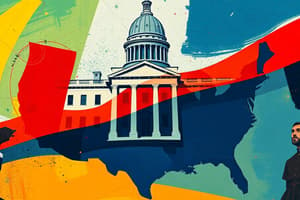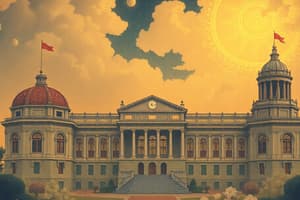Podcast
Questions and Answers
What is the division of power between the federal and state governments called?
What is the division of power between the federal and state governments called?
- Separation of Powers
- Popular Sovereignty
- Checks and Balances
- Federalism (correct)
Which clause grants Congress the power to make laws necessary for executing its enumerated powers?
Which clause grants Congress the power to make laws necessary for executing its enumerated powers?
- Equal Protection Clause
- Commerce Clause
- Supremacy Clause
- Necessary and Proper Clause (correct)
What are powers specifically listed in the Constitution as belonging to the federal government called?
What are powers specifically listed in the Constitution as belonging to the federal government called?
- Implied Powers
- Concurrent Powers
- Enumerated Powers (correct)
- Reserved Powers
Which amendment reserves powers not delegated to the federal government to the states?
Which amendment reserves powers not delegated to the federal government to the states?
Which level of government primarily relies on income taxes?
Which level of government primarily relies on income taxes?
What type of powers are shared by both the federal and state governments?
What type of powers are shared by both the federal and state governments?
Which of the following is a typical source of revenue for state governments?
Which of the following is a typical source of revenue for state governments?
Which clause states that federal law is supreme when in conflict with state law?
Which clause states that federal law is supreme when in conflict with state law?
Which of the following is an example of an enumerated power of the federal government?
Which of the following is an example of an enumerated power of the federal government?
Which federal agency is responsible for enforcing federal laws?
Which federal agency is responsible for enforcing federal laws?
Who has the main responsibility for establishing and overseeing public school systems?
Who has the main responsibility for establishing and overseeing public school systems?
Which of the following is an example of a reserved power of the state governments?
Which of the following is an example of a reserved power of the state governments?
What type of commerce does the federal government regulate?
What type of commerce does the federal government regulate?
Which level of government is responsible for administering elections?
Which level of government is responsible for administering elections?
Which of the following is an example of an area where states have broad regulatory authority?
Which of the following is an example of an area where states have broad regulatory authority?
In the case of McCulloch v. Maryland, what power was deemed 'necessary and proper' for the federal government?
In the case of McCulloch v. Maryland, what power was deemed 'necessary and proper' for the federal government?
Which federal agency sets national standards for environmental protection?
Which federal agency sets national standards for environmental protection?
What does federal law require for gun purchases?
What does federal law require for gun purchases?
Which level of government traditionally defines marriage and divorce laws?
Which level of government traditionally defines marriage and divorce laws?
Federal criminal laws generally cover offenses involving what?
Federal criminal laws generally cover offenses involving what?
Flashcards
Federalism
Federalism
Division of power between national and state governments.
Enumerated Powers
Enumerated Powers
Powers specifically listed in the Constitution for the federal government.
Implied Powers
Implied Powers
Powers inferred for the federal government to carry out enumerated powers.
Necessary and Proper Clause
Necessary and Proper Clause
Signup and view all the flashcards
Reserved Powers
Reserved Powers
Signup and view all the flashcards
Tenth Amendment
Tenth Amendment
Signup and view all the flashcards
Concurrent Powers
Concurrent Powers
Signup and view all the flashcards
Supremacy Clause
Supremacy Clause
Signup and view all the flashcards
Interstate Commerce
Interstate Commerce
Signup and view all the flashcards
Intrastate Commerce
Intrastate Commerce
Signup and view all the flashcards
Federal Government Funding
Federal Government Funding
Signup and view all the flashcards
State Government Funding
State Government Funding
Signup and view all the flashcards
Federal Law Enforcement
Federal Law Enforcement
Signup and view all the flashcards
State Law Enforcement:
State Law Enforcement:
Signup and view all the flashcards
State Government: Elections
State Government: Elections
Signup and view all the flashcards
State Powers: Public Health
State Powers: Public Health
Signup and view all the flashcards
Federal Environmental Role
Federal Environmental Role
Signup and view all the flashcards
Evolution of Federalism
Evolution of Federalism
Signup and view all the flashcards
Division of Powers
Division of Powers
Signup and view all the flashcards
Federalism: Conflict
Federalism: Conflict
Signup and view all the flashcards
Study Notes
- The U.S. Constitution establishes federalism, dividing power between the national (federal) government and state governments.
- The division is not absolute; some powers are exclusive, while others are shared.
Enumerated Powers (Federal Government)
- These are powers specifically listed in the Constitution as belonging to the federal government.
- These powers include declaring war, coining money, regulating interstate and foreign commerce, establishing post offices, and raising and supporting armies.
- The Necessary and Proper Clause (Article I, Section 8) allows Congress to make laws necessary to carry out its enumerated powers.
- The Necessary and Proper Clause has expanded federal power over time.
Implied Powers (Federal Government)
- These powers are not explicitly listed, but are inferred as necessary to carry out enumerated powers.
- Implied powers derive from the Necessary and Proper Clause.
- The Supreme Court case McCulloch v. Maryland (1819) affirmed the concept of implied powers.
- The ruling confirmed the federal government's power to establish a national bank, deemed necessary for regulating commerce and coining money, even though not explicitly in the Constitution.
Reserved Powers (State Governments)
- The Tenth Amendment reserves powers not delegated to the federal government, nor prohibited to the states, to the states or the people.
- Reserved powers include regulating intrastate commerce, establishing local governments, conducting elections, and providing for public health, safety, and morals.
- State governments can legislate on matters within their borders if they do not conflict with federal law or the Constitution.
Concurrent Powers (Shared)
- These powers are shared by both the federal and state governments.
- Concurrent powers include the power to tax, borrow money, establish courts, and enforce laws.
- The Supremacy Clause (Article VI) states that federal law is supreme when federal and state laws conflict.
Examples of Division of Powers
- Regulation of Commerce:
- The federal government regulates interstate (between states) and foreign commerce.
- Authority for regulating commerce is derived from the Commerce Clause (Article I, Section 8).
- State governments regulate intrastate commerce (within a state).
- Taxation:
- Both federal and state governments can tax.
- The federal government primarily relies on income taxes.
- State governments use income taxes, sales taxes, and property taxes.
- Law Enforcement:
- The federal government enforces federal laws through agencies like the FBI.
- State governments have their own law enforcement agencies, such as state and local police departments.
- There are court systems at both the federal and state levels.
- Federal courts handle cases involving federal law and disputes between states.
- State courts handle most criminal and civil cases.
- Education:
- Education is primarily a state responsibility.
- State governments establish and oversee public school systems.
- The federal government provides some funding and sets standards, but the states mainly control education.
- Elections:
- State governments administer elections, setting rules for voter registration and polling places.
- The federal government sets some standards, such as prohibiting discrimination in voting.
- Public Health and Safety:
- States regulate public health and safety within their borders.
- Regulation includes setting standards for food safety, regulating medical practices, and responding to emergencies.
- The federal government also plays a role, particularly in disease control (CDC) and workplace safety (OSHA).
- Environmental Regulation:
- Both levels of government are involved in environmental regulation.
- The federal government sets national standards and enforces laws like the Clean Air Act and Clean Water Act (EPA).
- State governments can also enact their own environmental laws, as long as they do not conflict with federal law.
- Gun Control:
- Both federal and state governments regulate firearms.
- Federal laws regulate certain weapons and require background checks for gun purchases.
- State laws vary widely, with some states having stricter gun control laws than others.
- Marriage and Family Law:
- Marriage and family law is traditionally a state responsibility.
- States define marriage, divorce, and child custody laws.
- The federal government has played a role in recent years, such as with the Supreme Court's decision legalizing same-sex marriage nationwide.
- Criminal Law:
- Both federal and state governments have their own criminal laws.
- Federal criminal laws generally cover offenses involving interstate commerce, federal property, or federal employees.
- State criminal laws cover a broader range of offenses.
Evolution of Federalism
- The balance of power between the federal and state governments has shifted over time.
- In the early years of the country, the states had more power.
- Over time, the federal government has grown in power, particularly during the Civil War and the New Deal era.
- There are ongoing debates about the balance of power between the two levels of government.
Significance
- The division of powers is a fundamental principle of American government.
- It helps prevent tyranny by dividing power between different levels of government.
- It also allows for flexibility and experimentation, as states can adopt different policies to address their unique needs.
- Federalism creates complexity and can lead to conflict between the federal and state governments.
Studying That Suits You
Use AI to generate personalized quizzes and flashcards to suit your learning preferences.




